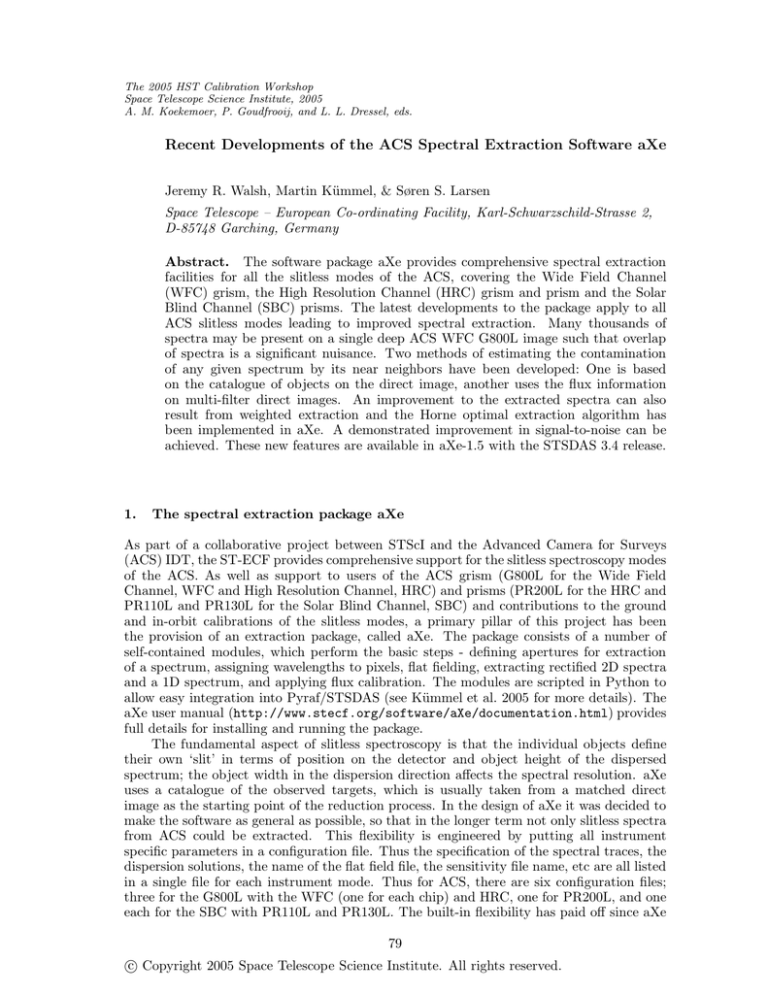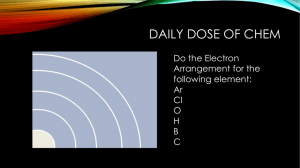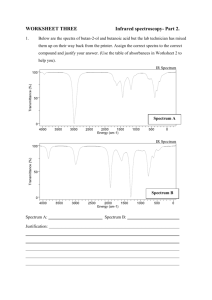
The 2005 HST Calibration Workshop
Space Telescope Science Institute, 2005
A. M. Koekemoer, P. Goudfrooij, and L. L. Dressel, eds.
Recent Developments of the ACS Spectral Extraction Software aXe
Jeremy R. Walsh, Martin Kümmel, & Søren S. Larsen
Space Telescope – European Co-ordinating Facility, Karl-Schwarzschild-Strasse 2,
D-85748 Garching, Germany
Abstract. The software package aXe provides comprehensive spectral extraction
facilities for all the slitless modes of the ACS, covering the Wide Field Channel
(WFC) grism, the High Resolution Channel (HRC) grism and prism and the Solar
Blind Channel (SBC) prisms. The latest developments to the package apply to all
ACS slitless modes leading to improved spectral extraction. Many thousands of
spectra may be present on a single deep ACS WFC G800L image such that overlap
of spectra is a significant nuisance. Two methods of estimating the contamination
of any given spectrum by its near neighbors have been developed: One is based
on the catalogue of objects on the direct image, another uses the flux information
on multi-filter direct images. An improvement to the extracted spectra can also
result from weighted extraction and the Horne optimal extraction algorithm has
been implemented in aXe. A demonstrated improvement in signal-to-noise can be
achieved. These new features are available in aXe-1.5 with the STSDAS 3.4 release.
1.
The spectral extraction package aXe
As part of a collaborative project between STScI and the Advanced Camera for Surveys
(ACS) IDT, the ST-ECF provides comprehensive support for the slitless spectroscopy modes
of the ACS. As well as support to users of the ACS grism (G800L for the Wide Field
Channel, WFC and High Resolution Channel, HRC) and prisms (PR200L for the HRC and
PR110L and PR130L for the Solar Blind Channel, SBC) and contributions to the ground
and in-orbit calibrations of the slitless modes, a primary pillar of this project has been
the provision of an extraction package, called aXe. The package consists of a number of
self-contained modules, which perform the basic steps - defining apertures for extraction
of a spectrum, assigning wavelengths to pixels, flat fielding, extracting rectified 2D spectra
and a 1D spectrum, and applying flux calibration. The modules are scripted in Python to
allow easy integration into Pyraf/STSDAS (see Kümmel et al. 2005 for more details). The
aXe user manual (http://www.stecf.org/software/aXe/documentation.html) provides
full details for installing and running the package.
The fundamental aspect of slitless spectroscopy is that the individual objects define
their own ‘slit’ in terms of position on the detector and object height of the dispersed
spectrum; the object width in the dispersion direction affects the spectral resolution. aXe
uses a catalogue of the observed targets, which is usually taken from a matched direct
image as the starting point of the reduction process. In the design of aXe it was decided to
make the software as general as possible, so that in the longer term not only slitless spectra
from ACS could be extracted. This flexibility is engineered by putting all instrument
specific parameters in a configuration file. Thus the specification of the spectral traces, the
dispersion solutions, the name of the flat field file, the sensitivity file name, etc are all listed
in a single file for each instrument mode. Thus for ACS, there are six configuration files;
three for the G800L with the WFC (one for each chip) and HRC, one for PR200L, and one
each for the SBC with PR110L and PR130L. The built-in flexibility has paid off since aXe
79
c Copyright 2005 Space Telescope Science Institute. All rights reserved.
80
Walsh, Kümmel & Larsen
has also been used to extract spectra from multi-object spectra taken with the VLT FORS2
instrument (Kümmel et al. 2006).
Since the first release of aXe in 2002 ready for installation of ACS into HST, the
package has evolved. In particular in 2004 a major enhancement was added with the use of
‘drizzle’ (Fruchter & Hook 2002) to combine 2D spectra of individual objects when the data
is taken with dithers of the telescope. This turns out to be a very common observational
procedure, at least for the grism modes, in order to recover the undersampling of the Point
Spread Function (PSF) and to mitigate the effect of pixel sensitivity variations and hot
pixels. Since the 2004 release (aXe-1.4), two enhancements have been added which are here
described. The sensitivity of the ACS slitless spectroscopy modes implies that, despite the
small pixel scale and compact PSF, even for high Galactic latitude fields, the surface density
of detected spectra on moderate exposures (> thousands of seconds) displays crowding and
overlap. A high priority was to indicate to the user which pixels in an extracted spectrum
are affected by overlap with spectra of other objects. This has now been implemented in a
quantitative way, whereby the estimated value of the contaminating flux contributing to a
spectrum pixel is output. The second enhancement was to apply the well known technique
of weighting by the spatial profile when forming a 1-D spectrum from the 2D spectrum on
the detector (optimal extraction of Horne 1986). Both these enhancements are described.
2.
Handling spectral contamination in aXe
The contamination of one spectrum by spectra of neighboring objects can be manifest in
several ways:
• overlap of the first order spectrum by the first order spectrum of a nearby object
situated in the projected direction of dispersion;
• overlap of first order spectra situated nearby but offset perpendicular to the dispersion
direction;
• both above cases combined and possibly involving spectral orders other than the first.
A particular case is that of the zeroth order of a bright object overlying a fainter object
spectrum. For the G800L grism, the zeroth order is similar in size to the dispersing object,
but slightly dispersed, so that it can resemble a broad emission line. If such a feature is
not recognized as a contaminating line it may lead to erroneous wavelength, and hence
redshift, assignment. Of course the effect of bright objects on faint object spectra is more
serious than the reverse case, and highlights the need for a warning of the contamination
which provides at least an estimate of the actual contaminating flux to a given spectrum.
In the first release of aXe, a minimal indicator of spectral contamination was implemented
which indicated the total number of other object spectra which fell within a pixel in the
extraction box of the given object. With aXe-1.5, a new scheme was implemented which
provides a robust estimate of how much contaminating flux contributes to a given pixel. The
contamination is estimated by making a simulated slitless image, which is achieved by one of
two methods. The simpler method takes the input catalogue and generates simulated images
as 2D Gaussians based on the image parameters, and is called the Gaussian Emission Model;
the other method actually uses the fluxes in the pixels of a set of multicolor companion direct
images, and is called the Fluxcube Emission Model.
2.1.
Gaussian Emission model
The input catalogue which drives the object extraction is usually produced by running
SExtractor on a companion direct image (or several images taken with different filters) and
lists the object position, size parameters and magnitude. Thus for each object a spectrum
ACS spectral extraction software aXe
81
Figure 1: Left. The scheme for generating the contamination model based on 2-D Gaussians
and an input catalogue with object shapes. The position, size (major and minor axes and
position angle) and magnitude of objects in different filter direct images provide simulated
objects which are dispersed onto the detector pixels, converted to e− s−1 . Right. As left
panel, but showing the procedure for generating the simulated images directly from the
photometric information in the pixels of the multicolor direct images.
over the wavelength extent of the slitless dispersing element can be formed and converted
to detector count rate using the known sensitivity of the slitless mode. For a single filter
this will be a flat featureless spectrum, but more filter bands can more closely match the
true object spectrum. From the position and extent of each object, which are determined
from the object parameters of each image (A IMAGE, B IMAGE and THETA IMAGE in
SExtractor), a simulated spectrum corresponding to the slitless spectrum can be formed
with spatial extent matching the object size (see Figure 1, left panel, for an overview).
2.2.
Fluxcube Emission model
An alternative, and preferable, method to produce the model spectrum for estimation of
the contribution of contaminating spectra is to use the surface brightness distribution in
the pixels of the companion direct image(s). The assignment of pixels to a given object still
has to be established and the method chosen in aXe-1.5 was to use the Segmentation image
provided by SExtractor. This image has the pixel value belonging to a given object set to
the object number in the SExtractor catalogue. The data are stored in an intermediate file
which is a cube with planes for the segmentation image and the filter images in different
bands; it is hence called a Fluxcube (see Figure 1, right panel). aXe-1.5 provides a routine to
produce such flux cubes which are then read by the appropriate tasks during the extraction
of the spectra.
2.3.
Quantitative contamination
During the extraction process for a given object spectrum, then, within the extraction box,
the count rate in the pixels belonging to objects other than the one being extracted are
accumulated from the contamination image (originating in either the Gaussian or Fluxcube
models) and assigned to the contaminating signal. Applying the sensitivity curve to the
contaminating signal enables the total contaminating signal to the spectrum to be computed.
The result is written to a separate column of the Extracted Spectra File by aXe. Figure 2
shows as an example the extracted spectrum of an i ∼ 24 mag. emission line galaxy; the
strong red continuum is shown to be badly contaminated (squares show the contamination
contribution). However the pair of emission lines at around 7500 Å can be seen to be intrinsic
to the object and not arise from a contaminating spectrum. It must be emphasized that
the quantitative contamination is only an estimate as it is based on a model (Gaussian
82
Walsh, Kümmel & Larsen
Figure 2: The extracted ACS WFC 1D spectrum of an emission line galaxy from the HUDF
parallel data (primary instrument was NICMOS (PI: Thompson, programme 9803). The
flux of the galaxy (with 1σ error bars) (diamonds) and the sum of the contaminating flux
in the extraction box (boxes) are shown.
or Fluxcube); it does however lead to an appropriate level of caution being exercised in
quantitatively assessing a given spectrum.
The aXe tasks for producing the emission model leading to contamination estimation
deliver simulated images from direct image(s) or a catalogue based on direct image(s). Thus
the slitless images produced by the Gaussian or Fluxcube models (....CONT.fits files) are
ideally suited to use in observation planning and exposure time estimation. For example
for a complex field, the contamination images can be used to choose optimal telescope roll
angles that minimize overlap of the spectra of interest.
3.
Weighted spectral extraction
If the 2D spectrum of an object is extracted applying a set of weights to the spatial profile,
then the resulting 1D spectrum has a higher signal-to-noise than the simple box-extracted
(i.e. summed) spectrum. This was shown by Horne (1986; see also Robertson 1986) and
is often referred to as optimal extraction. Weighted extraction has been implemented in
aXe-1.5, with the Horne (1986) algorithm, using weights derived from the contamination
image described in Section 2. The contamination image is well suited to providing the
weights since it is binned in the same way as the spectrum to be extracted and, as a
model, does not suffer from any systematic statistical effects. In the examples described by
Horne (1986), the weights are typically determined by fitting the observed spectrum in the
dispersion direction as a function of spatial offset. This procedure can be prone to failure
for weak spectra and where the whole spectral extent is not occupied by signal; in the case
of overlapping spectra it would provide incorrect weights.
Simulations were performed with a random star field composed of (spatially) wellsampled star images in order to test the optimal extraction implementation in aXe-1.5.
The quantitative contamination procedure in aXe using the Gaussian emission model was
employed to make simulated slitless spectra from a SExtractor catalogue; background and
noise were added and then the spectra were extracted with and without weighting. The gain
of weighted extraction was specified as the ratio of the signal-to-noises in the optimal to the
unweighted spectrum over a given range. As the signal-to-noise level decreases, the optimal
extraction shows an advantage over the unweighted extraction depending on the width of
the extraction (see Figure 3 where the extraction width is 6 times the object width). At the
lowest signal-to-noise level, the advantage is around a factor 1.4, equivalent to an increase
in exposure time of 1.9 over unweighted extraction.
ACS spectral extraction software aXe
83
Figure 3: The result of a simulation of a star field observed with the ACS WFC G800L
grism in terms of the signal-to-noise (S/N) advantage of the weighted over the unweighted
extraction (extraction widths ±3 σ of the sources). The lower plot shows the actual advantage for each star in the simulation (ratio of weighted S/N divided by unweighted S/N,
averaged over a wavelength range) in terms of the i mag. The upper plot shows a histogram
version of the lower plot where the plot abscissa is the mean signal-to-noise over a 1000Å
range.
As an example of weighted extraction applied to real ACS data, a crowded stellar field
was selected from archive data resulting from the APPLES programme (ACS Pure Parallel
Lyman-alpha Emission Survey, PI: J. Rhoads, Programme 9482). Over 7000 spectra (to i =
25 mag) were present on this ACS Wide Field Channel image so there is often considerable
contamination between adjacent spectra. Using the quantitative contamination, only those
spectra with <5% contamination were selected, and the advantage in signal-to-noise of
using weighted extraction was determined. The mean S/N was computed over a range of
1000 Å centred at 7500 Å and Figure 4 shows the result as a point plot v. magnitude and as a
histogram v. signal-to-noise. Here 1374 stars are analyzed, and a peak advantage of weighted
over unweighted extraction of about 1.3 is realized. This is somewhat lower than that
achieved in the simulations, but is probably on account of the narrow undersampled Point
Spread Function (PSF) of the WFC data. Nevertheless the theoretical gain in exposure
time is around 60% at low signal-to-noise.
Weighted extraction can be selected in the aXe parameter set and both weighted and
unweighted 1D spectra for all sources are output. For sources with complex cross dispersion
profiles, there will probably be little advantage of weighted extraction but for small objects,
such as faint stars and distant galaxies, a modest gain in signal-to-noise is achievable with
optimal extraction for slitless spectra.
The latest release aXe-1.5 provides both quantitative contamination and weighted extraction for all ACS slitless spectroscopy modes and is available from November 2005, with
Pyraf/STSDAS 3.4. Full details can be found at
http://www.stecf.org/software/aXe/
84
Walsh, Kümmel & Larsen
Figure 4: An identical plot to Figure 3, but now based on real data taken with the ACS
WFC G800L grism as part of HST APPLES programme 9482. The field is at low Galactic
latitude and consists of many late type stars. There is considerable scatter in the weighted
v. unweighted extraction advantage at the lowest signal level, but a demonstrable increase
in signal-to-noise at low flux levels is achieved.
References
Horne, K., 1986, PASP, 98, 609
Fruchter, A. S., & Hook, R. N., 2002, PASP, 114, 144
Kümmel, M., Larsen, S. S., & Walsh, J. R., 2006, The 2005 HST Calibration Workshop.
Eds. A. M. Koekemoer, P. Goudfrooij, & L. L. Dressel, this volume, 85
Kümmel, M., Kuntschner, H., Larsen, S. S, & Walsh, J. R., 2006, in Astronomical Data
Analysis Software and Systems XV. Eds., C. Gabriel, C. Arviset, D. Ponz, E. Solano
(Astronomical Society of the Pacific: San Francisco), in press
Robertson, J. G., 1986. PASP, 98, 1220









